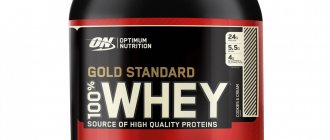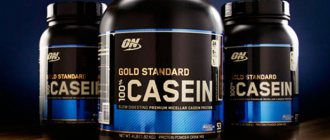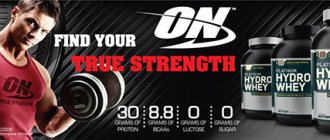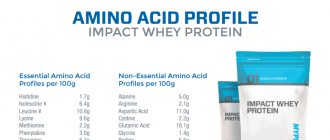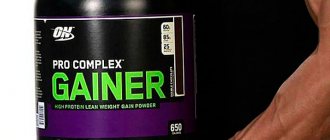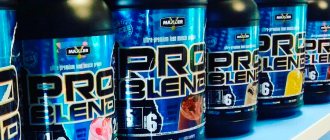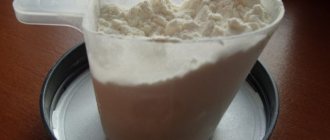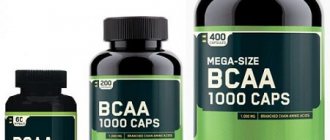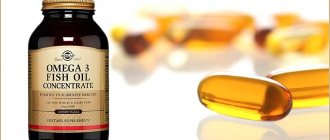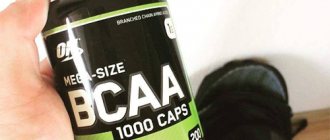Throughout the history of fitness, bodybuilding and strength sports in general, the views of athletes and scientists on how much protein is needed to gain and maintain muscle mass have changed dramatically.
Strength athletes of Ancient Greece believed that the secret of their strength was in red meat, and ate it to excess, and some modern scientists question not only the existence of a connection between strength indicators and the consumption of animal protein, but also the need for athletes to take it in higher doses compared to physically inactive people.
In this article, we'll look at what scientific research says about how much protein you need per day to gain and maintain muscle mass (for men, women and older adults).
Main thoughts:
Insufficient protein in the diet makes it impossible to repair muscle cells and grow muscle mass
Excess protein in the diet may increase the risk of developing serious diseases, including cancer, decreased bone density, and kidney stones.
Learn to listen to your body: both lack and excess of protein make themselves felt by unpleasant sensations and health problems
Scientists' recommendations regarding daily protein intake for athletes have changed dramatically throughout history. Even today they do not have a common position on this issue.
Scientific research confirms the increased need for protein in athletes of both strength and endurance sports. The daily protein requirement for male athletes is higher than for women
When protein is consumed by ordinary people in doses above 1.4 g/kg and by athletes above 2.4 g/kg, it is not used effectively in the body, increasing the risk of harm to health.
Scientific research suggests that the optimal amount for building muscle mass is 1.4 - 1.8 grams of protein per kilogram of body weight
For older physically active people (> 50 years), the daily protein requirement is as high as for young people
There is very little scientific research on how much protein is needed per day for women involved in sports and bodybuilding, in particular. A daily intake of 1.3 g/kg is believed to provide benefits for muscle gain
When calculating how much protein you need per day, it is important to take into account the type of protein: plant and animal proteins have different rates and degrees of absorption, as well as amino acid composition, so it is recommended to increase the daily intake of plant proteins beyond the recommended
The frequency of protein intake is not particularly important. It is recommended to take protein before bed and after training
Protein shelf life
The manufacturer will always indicate the average statistical marking on the can. It determines when the expiration date has expired. Shelf life is 1-3 years for unopened containers. If the tightness is broken, then you should drink the course in a short time. The storage period of the additive depends on:
- Coolness, lack of heating devices;
- Darkness of the storage area;
- No high humidity;
- Maintaining the integrity of the packaging.
The country of origin also affects the quality of the product. Thus, American brands are considered the best among competitors in terms of “endurance”. Products of this kind are stored for up to 3 years, and European ones - up to 2. The criterion depends on the degree of industrial purification, preservatives, and production method.
Powder for athletes is often prepared from milk and its derivatives. Therefore, the shelf life of sports nutrition depends on the form of the product - dry or diluted.
Is it possible to eat expired protein?
The manufacturer prefers to set the expiration date on its own product in the context of a guarantee, that is, a person will get the maximum benefit from the drug if the protein powder is stored according to the recommendations. Further, if the storage period has expired, the person takes the product at his own peril and risk. A mandatory certification condition provides for a maximum shelf life of 3 years for an unopened product, and up to a month for an opened product. Whether it can be used further depends on the condition of the protein powder.
Expired powder is used when the period of 1-6 months has expired and there is no change in the physical properties of the sports nutrition. But the manufacturer is not responsible for the consequences. A year from the end date, the protein will be expired and unsafe for the athlete. You need to look at each package for how long to store the composition. If you take an expired drug, the consequences of such a choice can affect more than one day.
You should not expect a fatal outcome from consuming expired sports nutrition. Symptoms are limited to signs of gastrointestinal dysfunction, that is, flatulence, diarrhea, belching. Such manifestations can be easily eliminated using standard pharmaceutical products. But if the deadline has expired, it is not recommended to risk your health.
https://youtu.be/BZnWEumUAHc
We pay attention to details
When planning the dosage and timing of protein intake, one important thing to consider is that there are “slow” and “fast” proteins. That is, one group of proteins is absorbed by the body in 5-7 hours, and the other in 20-50 minutes. The difference is significant, you will agree. Now for examples.
One of the most popular and sought after supplements among bodybuilders is whey protein. The main reason is the high percentage of protein (in isolate it can reach 95%), excellent digestibility by the body (from 20 to 50 minutes) and a rich composition of amino acids, which is so necessary for muscle fibers for growth and recovery. If you need to quickly charge and “nourish” the body after a workout, whey “fast” protein comes to the rescue.
In turn, casein and soy proteins are “slow” - the body absorbs them within 5-7 hours. But this does not mean that their composition is worse than that of their competitors. Not at all. The whole difference is in the structure of the protein, which is difficult to break down in the stomach. But if taken correctly, this is more of a plus than a minus. Eating “slow” protein is a chance to stop catabolic processes in the body and provide muscles with amino acids for many hours to come.
https://youtu.be/CUVle2FOumA
Shelf life after opening
Since the drug is distributed in a state almost ready for consumption, it should be taken according to the instructions, in a clearly prescribed course. After opening the can, the dates originally printed on the box are reduced to 2-4 weeks. Whether the composition can be eaten after this time will depend on the safety of the product.
After the seal is broken, processes begin to occur in the protein. The product gradually oxidizes and breaks down. In 3-5 weeks the product loses its properties. Protein before the packaging is broken gives a positive effect from use when it is expired, but an opened product is not able to maintain the initial benefits at the original level. Therefore, the protein will be useless after the expiration time.
Due to the sharp reduction in the shelf life of the protein, it is recommended to open the jar when a course of drying or relief creation is planned and constant auxiliary means are required.
Final word
If your goal is to gain lean mass and lose excess fat, the benefits of a high-protein diet combined with strength training are clear. My team and I at the University of South Florida recommend that women consume approximately 2.25 grams of complete protein per pound of body weight daily to improve body composition and optimize post-workout recovery. So, put down your salad fork, or at least add some chicken to your salad!
Protein for gaining muscle mass
Optimum Nutrition Gold Standard 100% Whey
Fast-absorbing whey protein. Contains whey protein isolates and easily digestible Hydrowhey whey peptides.
Dymatize Elite Whey Protein Isolate
Low-carb whey protein is an ideal choice for those watching their weight!
BSN Syntha-6
Universal complex protein, contains 6 different types of protein with different rates of absorption, from slow casein to fast isolate.
Shelf life of diluted protein
A protein shake has an even shorter shelf life than an opened product. The factor is explained by the fact that when diluted, the powder takes on a new, easily digestible form. Accordingly, decay processes proceed many times faster. It is advisable to take the composition immediately after dilution. Protein in storage will quickly lose its primary parameters and properties.
If we consider how long a diluted protein can be stored, then the extreme threshold for storing a cocktail is 3.5 hours for storage at room temperature, or 5 hours if the composition is placed on a refrigerator shelf. Is it possible to drink expired protein shakes? Certainly. But further diluted powder will be useless.
Recipe Cheesecake 1 scoop of protein. Calorie, chemical composition and nutritional value.
Nutritional value and chemical composition of “Vatrushka 1 stingy protein”.
The table shows the nutritional content (calories, proteins, fats, carbohydrates, vitamins and minerals) per 100 grams of edible portion.
| Nutrient | Quantity | Norm** | % of the norm in 100 g | % of the norm in 100 kcal | 100% normal |
| Calorie content | 123 kcal | 1684 kcal | 7.3% | 5.9% | 1369 g |
| Squirrels | 18.1 g | 76 g | 23.8% | 19.3% | 420 g |
| Fats | 4.1 g | 56 g | 7.3% | 5.9% | 1366 g |
| Carbohydrates | 3.5 g | 219 g | 1.6% | 1.3% | 6257 g |
| Water | 19.4 g | 2273 g | 0.9% | 0.7% | 11716 g |
| Ash | 0.319 g | ~ | |||
| Vitamins | |||||
| Vitamin A, RE | 51.8 mcg | 900 mcg | 5.8% | 4.7% | 1737 |
| Retinol | 0.045 mg | ~ | |||
| beta carotene | 0.012 mg | 5 mg | 0.2% | 0.2% | 41667 g |
| Vitamin B1, thiamine | 0.015 mg | 1.5 mg | 1% | 0.8% | 10000 g |
| Vitamin B2, riboflavin | 0.103 mg | 1.8 mg | 5.7% | 4.6% | 1748 g |
| Vitamin B4, choline | 45.82 mg | 500 mg | 9.2% | 7.5% | 1091 g |
| Vitamin B5, pantothenic | 0.237 mg | 5 mg | 4.7% | 3.8% | 2110 g |
| Vitamin B6, pyridoxine | 0.026 mg | 2 mg | 1.3% | 1.1% | 7692 g |
| Vitamin B9, folates | 2.211 mcg | 400 mcg | 0.6% | 0.5% | 18091 g |
| Vitamin B12, cobalamin | 0.095 mcg | 3 mcg | 3.2% | 2.6% | 3158 g |
| Vitamin C, ascorbic acid | 0.06 mg | 90 mg | 0.1% | 0.1% | 150000 g |
| Vitamin D, calciferol | 0.402 mcg | 10 mcg | 4% | 3.3% | 2488 g |
| Vitamin E, alpha tocopherol, TE | 0.15 mg | 15 mg | 1% | 0.8% | 10000 g |
| Vitamin H, biotin | 3.688 mcg | 50 mcg | 7.4% | 6% | 1356 g |
| Vitamin K, phylloquinone | 0.1 mcg | 120 mcg | 0.1% | 0.1% | 120000 g |
| Vitamin RR, NE | 0.8438 mg | 20 mg | 4.2% | 3.4% | 2370 g |
| Niacin | 0.05 mg | ~ | |||
| Macronutrients | |||||
| Potassium, K | 52.79 mg | 2500 mg | 2.1% | 1.7% | 4736 g |
| Calcium, Ca | 32.61 mg | 1000 mg | 3.3% | 2.7% | 3067 g |
| Magnesium, Mg | 4.8 mg | 400 mg | 1.2% | 1% | 8333 g |
| Sodium, Na | 33.79 mg | 1300 mg | 2.6% | 2.1% | 3847 g |
| Sera, S | 32.13 mg | 1000 mg | 3.2% | 2.6% | 3112 g |
| Phosphorus, Ph | 52 mg | 800 mg | 6.5% | 5.3% | 1538 g |
| Chlorine, Cl | 49.2 mg | 2300 mg | 2.1% | 1.7% | 4675 g |
| Microelements | |||||
| Iron, Fe | 0.476 mg | 18 mg | 2.6% | 2.1% | 3782 g |
| Yod, I | 5.52 mcg | 150 mcg | 3.7% | 3% | 2717 g |
| Cobalt, Co | 2.012 mcg | 10 mcg | 20.1% | 16.3% | 497 g |
| Manganese, Mn | 0.0063 mg | 2 mg | 0.3% | 0.2% | 31746 g |
| Copper, Cu | 17.64 mcg | 1000 mcg | 1.8% | 1.5% | 5669 g |
| Molybdenum, Mo | 2.132 mcg | 70 mcg | 3% | 2.4% | 3283 g |
| Tin, Sn | 3.11 mcg | ~ | |||
| Selenium, Se | 5.995 mcg | 55 mcg | 10.9% | 8.9% | 917 g |
| Fluorine, F | 14.19 mcg | 4000 mcg | 0.4% | 0.3% | 28189 g |
| Chromium, Cr | 1.14 mcg | 50 mcg | 2.3% | 1.9% | 4386 g |
| Zinc, Zn | 0.2855 mg | 12 mg | 2.4% | 2% | 4203 g |
| Digestible carbohydrates | |||||
| Mono- and disaccharides (sugars) | 1.1 g | max 100 g | |||
| Galactose | 0.015 g | ~ | |||
| Lactose | 0.974 g | ~ | |||
| Essential amino acids | 0.252 g | ~ | |||
| Arginine* | 0.166 g | ~ | |||
| Valin | 0.174 g | ~ | |||
| Histidine* | 0.078 g | ~ | |||
| Isoleucine | 0.143 g | ~ | |||
| Leucine | 0.254 g | ~ | |||
| Lysine | 0.21 g | ~ | |||
| Methionine | 0.092 g | ~ | |||
| Methionine + Cysteine | 0.152 g | ~ | |||
| Threonine | 0.138 g | ~ | |||
| Tryptophan | 0.045 g | ~ | |||
| Phenylalanine | 0.149 g | ~ | |||
| Phenylalanine+Tyrosine | 0.268 g | ~ | |||
| Nonessential amino acids | 0.351 g | ~ | |||
| Alanin | 0.147 g | ~ | |||
| Aspartic acid | 0.263 g | ~ | |||
| Glycine | 0.085 g | ~ | |||
| Glutamic acid | 0.45 g | ~ | |||
| Proline | 0.126 g | ~ | |||
| Serin | 0.203 g | ~ | |||
| Tyrosine | 0.12 g | ~ | |||
| Cysteine | 0.058 g | ~ | |||
| Sterols (sterols) | |||||
| Cholesterol | 106.13 mg | max 300 mg | |||
| beta sitosterol | 0.164 mg | ~ | |||
| Saturated fatty acids | |||||
| Saturated fatty acids | 1 g | max 18.7 g | |||
| 10:0 Kaprinovaya | 0.008 g | ~ | |||
| 12:0 Lauric | 0.021 g | ~ | |||
| 14:0 Miristinovaya | 0.092 g | ~ | |||
| 15:0 Pentadecane | 0.01 g | ~ | |||
| 16:0 Palmitinaya | 0.626 g | ~ | |||
| 17:0 Margarine | 0.012 g | ~ | |||
| 18:0 Stearic | 0.25 g | ~ | |||
| 20:0 Arakhinovaya | 0.007 g | ~ | |||
| Monounsaturated fatty acids | 1.241 g | min 16.8 g | 7.4% | 6% | |
| 14:1 Myristoleic | 0.002 g | ~ | |||
| 16:1 Palmitoleic | 0.101 g | ~ | |||
| 17:1 Heptadecene | 0.002 g | ~ | |||
| 18:1 Oleic (omega-9) | 1.042 g | ~ | |||
| 20:1 Gadoleic (omega-9) | 0.012 g | ~ | |||
| Polyunsaturated fatty acids | 0.269 g | from 11.2 to 20.6 g | 2.4% | 2% | |
| 18:2 Linolevaya | 0.237 g | ~ | |||
| 18:3 Linolenic | 0.011 g | ~ | |||
| 20:4 Arachidonic | 0.018 g | ~ | |||
| Omega-6 fatty acids | 0.3 g | from 4.7 to 16.8 g | 6.4% | 5.2% |
The energy value of Cheesecake 1 scoop of protein is 123 kcal.
Primary Source: Created in the application by the user. Read more.
** This table shows the average levels of vitamins and minerals for an adult. If you want to know the norms taking into account your gender, age and other factors, then use the “My Healthy Diet” application.
How can you tell if your protein has gone bad?
A similar condition occurs when storage conditions are violated or the expiration date expires. How to understand that there is spoiled protein in a jar can best be determined by the structure of the sports nutrition product. If the following signs are observed, then taking this composition is prohibited:
- Changing the color of the product, acquiring transparency;
- Changing the structure of the product;
- The appearance of an unpleasant, vile smell of rotting;
- Development of mold on the surface of the product.
How long the drug is stored depends on the content of the product. If the protein has spoiled, it is better to dispose of it.
How to store protein?
The period of sale of the drug is reduced due to incorrect storage of the composition. Then it is the person’s own fault if the protein spoils ahead of time. Accordingly, drinking such a powder is useless, since there are simply no results. To prevent the product from spoiling, it is necessary to keep the mixture, taking into account the storage rules:
- The optimal range is 20-25°C, but manufacturers often indicate 5-30°C as extreme thresholds.
- Storage location: cool, dark and dry area.
- After each use, the product is tightly closed so that the composition does not absorb moisture or foreign odors.
- The product should not be placed near a heat source.
If these conditions are violated, the powder becomes infected with bacteria. Then the composition begins to quickly lose its original structure.
If water gets into the jar, it should be left open in a dry place, but the product should not be exposed to direct sunlight.
The shelf life of protein after opening the package largely depends on two factors. The proliferation of pathogenic microorganisms in it depends on the tightness of the packaging and disinfection of the composition during production. Preservatives also help in preserving sports nutrition. In the absence of the presented substances, the product deteriorates quickly. If the product has not changed its structure, it means that the protein remains safe for consumption. Expensive brands “last” longer and provide their product with a longer protein shelf life. Then you can take it to obtain positive effects from the powder if the expiration date has expired.
If we summarize the above and answer the question of whether it is possible to use open protein or an expired drug, then it becomes clear that everything here is conditional. Therefore, after the expiration date, the expired protein can be disposed of in the standard way and a high-quality new powder can be purchased.

